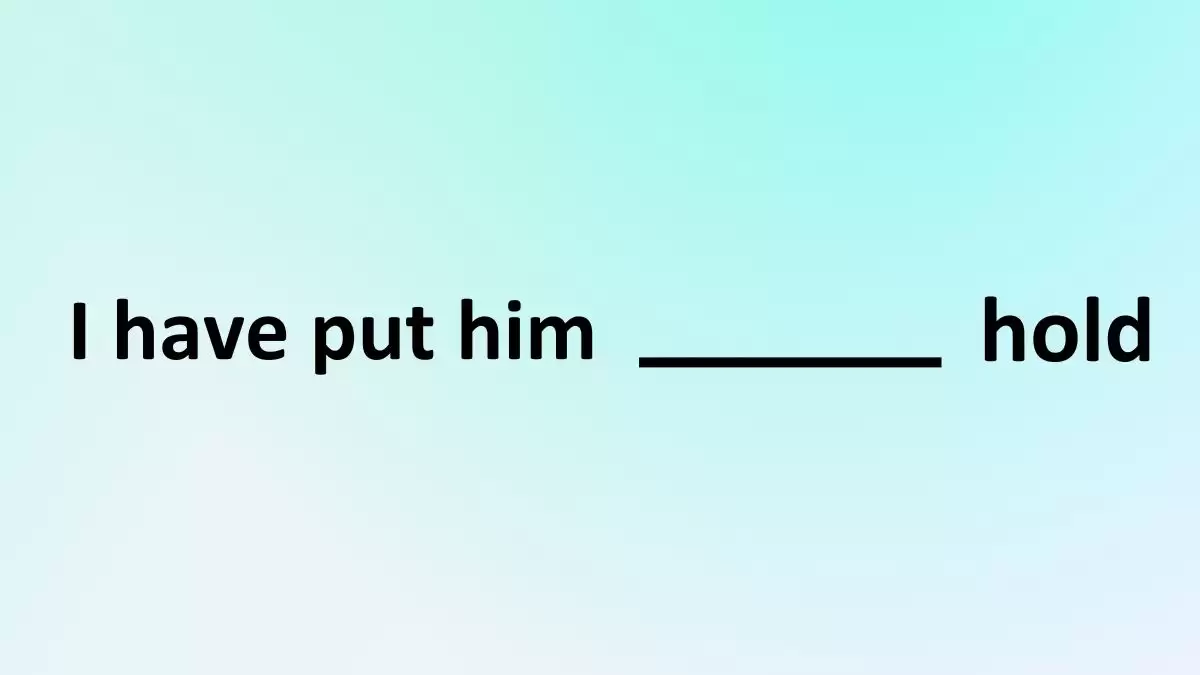Can you solve the five grammar challenges?
Explore the world of grammar puzzles. These puzzles engage readers by presenting situations that require you to use your grammar skills and creative thinking. They keep your mind active and may help reduce stress. There are many different grammar challenges to enjoy, including the ones that are coming next.
This challenge is a little tricky and is for those who are really good at grammar and notice the little things. When you master this type of puzzle, you get more than just fun, it provides you with skills that are useful in many aspects of life. Although the puzzle may seem difficult at first, your goal is to find a solution that fully follows the rules of grammar and uncover the secrets of the puzzle. The following sections explain this syntax dilemma in detail and show you how to solve it.
1.I have caught him ___
The word “on” in the sentence “I have put his on Hold” is used to indicate that someone is temporarily put on hold or continues to wait. In this case, it’s a commonly used phrase in customer service or phone conversations. When you put someone on “hold,” it means you put a call or conversation in a state where the other person has to wait for a period of time. The preposition “on” is used here to express the idea of being in a waiting or suspended state. It’s like “putting” a person in a waiting line or waiting area during a conversation.

2. I will call you in the morning ___
The word “in” in the sentence “I’ll call you in the morning” is used to specify the time at which the call action occurs. In this case, “morning” is a specific time period, and “in” helps determine when the action occurred. So when someone says they will do something “in the morning,” it means they plan to make the call during a time period considered morning (usually before noon). In this case, “in” is crucial because it pinpoints when the action (in this case, a phone call) occurred, providing a clear understanding of the time frame.

3. Vegetables are good for you___
The word “for” in the sentence “vegetables are good for you” is used to indicate a beneficial or supportive relationship between vegetables and your health. It connects the subject “vegetables” with the object “you” and expresses that eating vegetables has a positive impact on your health. In this case, “for” is a preposition indicating the purpose or merit of something. It emphasizes that vegetables are good or beneficial to your health. This use of “for” is a fundamental aspect of English grammar, showing how one thing is advantageous, helpful, or suitable for another.

4. It’s good to be back
The word “to” in the sentence “It’s good to be back” is used to express a specific state or situation. In this case, “to” is an infinitive marker. The infinitive is the base form of a verb, usually preceded by “to”. In this case, “to be” is the infinitive form of the verb “be.” This sentence expresses the state of returning or coming back, and “to” introduces this infinitive verb phrase. “Come back” is good, meaning that being in the state of returning or coming back is a positive or pleasant state. This use of “to” is a fundamental aspect of English grammar, emphasizing a state or action that is considered advantageous.

5. She is more ___ than I thought
The word “old” in the sentence “She is older than I thought” is a comparative adjective. Comparative adjectives are used to compare two or more things to show the difference in degree or quality between them. In this case, it compares the person’s (her) age to the speaker’s previous expectations. The phrase “than I thought” indicates a comparison with what the speaker previously believed or expected. Therefore, “older” is used to express that a woman is older than the speaker originally estimated or imagined.

Calculate 8396 ÷ 52 + 142 x 5 – 2176 ÷ 44=?
To find the solution, remember the order of operations. Division and multiplication proceed from left to right: 8396 ÷ 52 equals 161, and 2176 ÷ 44 equals 49. The equation becomes 161 + 142 x 5 – 49. Now, perform multiplication and addition/subtraction from left to right: 142 x 5 equals 710, and 161 + 710 equals 871. Therefore, the solution is 871.
Whether you’re a student, a professional, or someone who just enjoys a good mental workout, NEWSTARS Education is your destination. Our brainteasers vary in complexity, ensuring something for everyone.
trend
Find the result of 7024 ÷ 56 + 135 x 6 – 2245 ÷ 49=?
In this problem, order of operations applies. Division and multiplication proceed from left to right: 7024 ÷ 56 equals 126, and 2245 ÷ 49 equals 45. The equation becomes 126 + 135 x 6 – 45. Next, multiply, add and subtract from left to right: 135 x 6 equals 810, and 126 + 810 equals 936. Therefore, the answer is 936.
Disclaimer: The above information is for general information purposes only. All information on this website is provided in good faith, but we make no representations or warranties, express or implied, as to the accuracy, adequacy, validity, reliability, availability or completeness of any information on this website.
